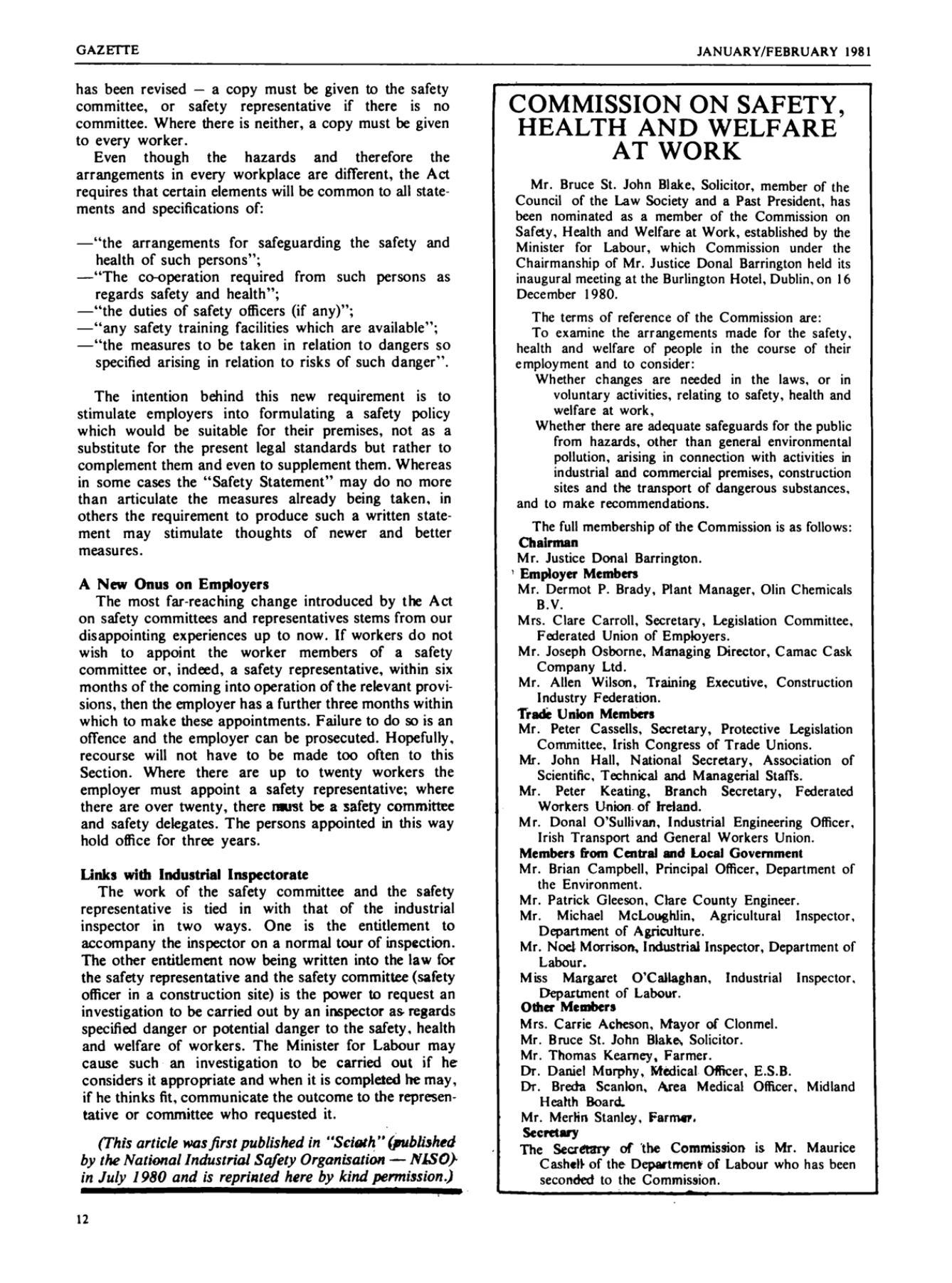

GAZETTE
JANUARY/FEBRUARY 1981
has been revised — a copy must be given to the safety
committee, or safety representative if there is no
committee. Where there is neither, a copy must be given
to every worker.
Even though the hazards and therefore the
arrangements in every workplace are different, the Act
requires that certain elements will be common to all state-
ments and specifications of:
—"the arrangements for safeguarding the safety and
health of such persons";
—"The co-operation required from such persons as
regards safety and health";
—"the duties of safety officers (if any)";
—"any safety training facilities which are available";
—"the measures to be taken in relation to dangers so
specified arising in relation to risks of such danger".
The intention behind this new requirement is to
stimulate employers into formulating a safety policy
which would be suitable for their premises, not as a
substitute for the present legal standards but rather to
complement them and even to supplement them. Whereas
in some cases the "Safety Statement" may do no more
than articulate the measures already being taken, in
others the requirement to produce such a written state-
ment may stimulate thoughts of newer and better
measures.
A New Onus on Employers
The most far-reaching change introduced by the Act
on safety committees and representatives stems from our
disappointing experiences up to now. If workers do not
wish to appoint the worker members of a safety
committee or, indeed, a safety representative, within six
months of the coming into operation of the relevant provi-
sions, then the employer has a further three months within
which to make these appointments. Failure to do so is an
offence and the employer can be prosecuted. Hopefully,
recourse will not have to be made too often to this
Section. Where there are up to twenty workers the
employer must appoint a safety representative; where
there are over twenty, there must be a safety committee
and safety delegates. The persons appointed in this way
hold office for three years.
Links with Industrial Inspectorate
The work of the safety committee and the safety
representative is tied in with that of the industrial
inspector in two ways. One is the entitlement to
accompany the inspector on a normal tour of inspection.
The other entitlement now being written into the law for
the safety representative and the safety committee (safety
officer in a construction site) is the power to request an
investigation to be carried out by an inspector as- regards
specified danger or potential danger to the safety, health
and welfare of workers. The Minister for Labour may
cause such an investigation to be carried out if he
considers it appropriate and when it is completed he may,
if he thinks fit, communicate the outcome to the represen-
tative or committee who requested it.
(This article was first published in "Scioth " (published
by the National Industrial Safety Organisation — NISO}
in July 1980 and is reprinted here by kind permission.)
COMMISSION ON SAFETY,
HEALTH AND WELFARE
AT WORK
Mr. Bruce St. John Blake, Solicitor, member of the
Council of the Law Society and a Past President, has
been nominated as a member of the Commission on
Safety, Health and Welfare at Work, established by the
Minister for Labour, which Commission under the
Chairmanship of Mr. Justice Donal Barrington held its
inaugural meeting at the Burlington Hotel, Dublin, on 16
December 1980.
The terms of reference of the Commission are:
To examine the arrangements made for the safety,
health and welfare of people in the course of their
employment and to consider:
Whether changes are needed in the laws, or in
voluntary activities, relating to safety, health and
welfare at work,
Whether there are adequate safeguards for the public
from hazards, other than general environmental
pollution, arising in connection with activities in
industrial and commercial premises, construction
sites and the transport of dangerous substances,
and to make recommendations.
The full membership of the Commission is as follows:
Chairman
Mr. Justice Donal Barrington.
1
Employer Members
Mr. Dermot P. Brady, Plant Manager, Olin Chemicals
B.V.
Mrs. Clare Carroll, Secretary, Legislation Committee,
Federated Union of Employers.
Mr. Joseph Osborne, Managing Director, Camac Cask
Company Ltd.
Mr. Allen Wilson, Training Executive, Construction
Industry Federation.
Trade Union Members
Mr. Peter Cassells, Secretary, Protective Legislation
Committee, Irish Congress of Trade Unions.
Mr. John Hall, National Secretary, Association of
Scientific, Technical and Managerial Staffs.
Mr. Peter Keating, Branch Secretary, Federated
Workers Union of Ireland.
Mr. Donal O'Sullivan, Industrial Engineering Officer,
Irish Transport and General Workers Union.
Members from Central and Local Government
Mr. Brian Campbell, Principal Officer, Department of
the Environment.
Mr. Patrick Gleeson, Clare County Engineer.
Mr. Michael McLoughlin, Agricultural Inspector,
Department of Agriculture.
Mr. Noel Morrison, Industrial Inspector, Department of
Labour.
Miss Margaret O'Callaghan, Industrial Inspector.
Department of Labour.
Other Members
Mrs. CarFie Acheson, Mayor of Clonmel.
Mr. Bruce St. John Blake> Solicitor.
Mr. Thomas Kearney, Farmer.
Dr. Daniel Morphy, Medical Officer, E.S.B.
Dr. Breda Scanlon, Area Medical Officer, Midland
Heahh Board.
Mr. Merlin Stanley, Farmer.
Secretary
The Secretary of the Commission is Mr. Maurice
Cashelt- of the Department of Labour who has been
seconded to the Commission.
12
















